
A mixing console or mixing desk is an electronic device for mixing audio signals, used in sound recording and reproduction and sound reinforcement systems. Inputs to the console include microphones, signals from electric or electronic instruments, or recorded sounds. Mixers may control analog or digital signals. The modified signals are summed to produce the combined output signals, which can then be broadcast, amplified through a sound reinforcement system or recorded.

A recording studio is a specialized facility for recording and mixing of instrumental or vocal musical performances, spoken words, and other sounds. They range in size from a small in-home project studio large enough to record a single singer-guitarist, to a large building with space for a full orchestra of 100 or more musicians. Ideally, both the recording and monitoring spaces are specially designed by an acoustician or audio engineer to achieve optimum acoustic properties.
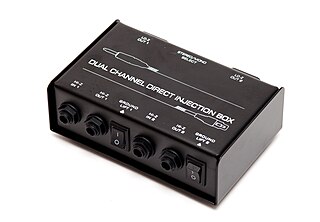
A DI unit is an electronic device typically used in recording studios and in sound reinforcement systems to connect a high output impedance unbalanced output signal to a low-impedance, microphone level, balanced input, usually via an XLR connector and XLR cable. DIs are frequently used to connect an electric guitar or electric bass to a mixing console's microphone input jack. The DI performs level matching, balancing, and either active buffering or passive impedance matching/impedance bridging. DI units are typically metal boxes with input and output jacks and, for more expensive units, “ground lift” and attenuator switches.

A stage box is an interface device used in sound reinforcement and recording studios to connect equipment to a mixing console. It provides a central location to connect microphones, instruments, and speakers to a multicore cable (snake), which allows the sound desk to be further from the stage and simplifies setup.

A sound reinforcement system is the combination of microphones, signal processors, amplifiers, and loudspeakers in enclosures all controlled by a mixing console that makes live or pre-recorded sounds louder and may also distribute those sounds to a larger or more distant audience. In many situations, a sound reinforcement system is also used to enhance or alter the sound of the sources on the stage, typically by using electronic effects, such as reverb, as opposed to simply amplifying the sources unaltered.
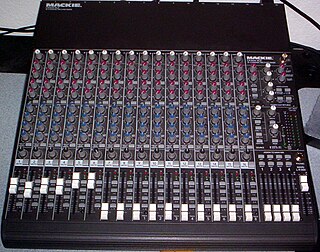
Mackie is an American professional audio products brand. Founded in Seattle in 1988 by Greg Mackie, a manufacturer of affordable and versatile compact pro audio mixers, Mackie is the primary product line of LOUD Technologies.
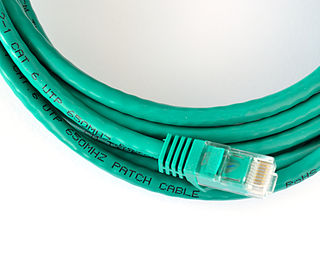
A patch cable, patch cord or patch lead is an electrical or fiber-optic cable used to connect one electronic or optical device to another for signal routing. Devices of different types are connected with patch cords.

A DJ mixer is a type of audio mixing console used by disc jockeys (DJs) to control and manipulate multiple audio signals. Some DJs use the mixer to make seamless transitions from one song to another when they are playing records at a dance club. Hip hop DJs and turntablists use the DJ mixer to play record players like a musical instrument and create new sounds. DJs in the disco, house music, electronic dance music and other dance-oriented genres use the mixer to make smooth transitions between different sound recordings as they are playing. The sources are typically record turntables, compact cassettes, CDJs, or DJ software on a laptop. DJ mixers allow the DJ to use headphones to preview the next song before playing it to the audience. Most low- to mid-priced DJ mixers can only accommodate two turntables or CD players, but some mixers can accommodate up to six turntables or CD players. DJs and turntablists in hip hop music and nu metal use DJ mixers to create beats, loops and so-called scratching sound effects.
Re-amping is a process often used in multitrack recording in which a recorded signal is routed back out of the editing environment and run through external processing using effects units and then into a guitar amplifier and a guitar speaker cabinet or a reverb chamber. Originally, the technique was used mostly for electric guitars: it facilitates a separation of guitar playing from guitar amplifier processing—a previously recorded audio program is played back and re-recorded at a later time for the purpose of adding effects, ambiance such as reverb or echo, and the tone shaping imbued by certain amps and cabinets. The technique has since evolved over the 2000s to include many other applications. Re-amping can also be applied to other instruments and program, such as recorded drums, synthesizers, and virtual instruments.

In professional audio, a digital mixing console (DMC) is a type of mixing console used to combine, route, and change the dynamics, equalization and other properties of multiple audio input signals, using digital signal processing rather than analog circuitry. The digital audio samples, which is the internal representation of the analog inputs, are summed to what is known as a master channel to produce a combined output. A professional digital mixing console is a dedicated desk or control surface produced exclusively for the task and is typically more robust in terms of user control, processing power and quality of audio effects. However, a computer can also perform the same function since it can mimic its interface, input and output.

Live sound mixing is the blending of multiple sound sources by an audio engineer using a mixing console or software. Sounds that are mixed include those from instruments and voices which are picked up by microphones and pre-recorded material, such as songs on CD or a digital audio player. Individual sources are typically equalised to adjust the bass and treble response and routed to effect processors to ultimately be amplified and reproduced via a loudspeaker system. The live sound engineer listens and balances the various audio sources in a way that best suits the needs of the event.

Arthur Rupert Neve was a British-American electronics engineer and entrepreneur, who was a pioneering designer of professional audio recording equipment. He designed analog recording and audio mixing equipment that was sought after by professional musicians and recording technicians. Some of his customers were music groups The Beatles, Aerosmith and Nirvana, and recording studios Sound City Studios and Abbey Road Studios. Companies that he was associated with included Neve Electronics, Focusrite, AMS Neve, and Rupert Neve Designs.
An audio signal is a representation of sound, typically using either a changing level of electrical voltage for analog signals, or a series of binary numbers for digital signals. Audio signals have frequencies in the audio frequency range of roughly 20 to 20,000 Hz, which corresponds to the lower and upper limits of human hearing. Audio signals may be synthesized directly, or may originate at a transducer such as a microphone, musical instrument pickup, phonograph cartridge, or tape head. Loudspeakers or headphones convert an electrical audio signal back into sound.

Yamaha Pro Audio, Inc. is the Pro Audio Division division of Yamaha Corporation that offers a complete line of beginner professional audio products for the live sound and sound reinforcement markets. Their lineup includes a number of world-standard mixing consoles, signal processors incorporating industry-leading DSP technology, power amplifiers based on energy-efficient drive technology, and an extensive range of speakers used for live sound or commercial installations. It has a long history of introducing significant products for the professional audio market such as the PM-1000 modular mixing console, the REV1 and SPX90 digital signal processors, the NS-10 studio monitors, and the 01v, 02R, 03D, PM1D, PM5D, QL5, M7CL, CL5, and PM10/7 Rivage digital mixing consoles.
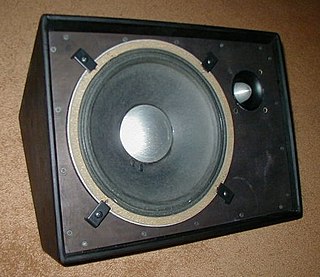
A stage monitor system is a set of performer-facing loudspeakers called monitor speakers, stage monitors, floor monitors, wedges, or foldbacks on stage during live music performances in which a sound reinforcement system is used to amplify a performance for the audience. The monitor system allows musicians to hear themselves and fellow band members clearly.

An audio engineer helps to produce a recording or a live performance, balancing and adjusting sound sources using equalization, dynamics processing and audio effects, mixing, reproduction, and reinforcement of sound. Audio engineers work on the "technical aspect of recording—the placing of microphones, pre-amp knobs, the setting of levels. The physical recording of any project is done by an engineer…"

In sound recording and reproduction, audio mixing is the process of optimizing and combining multitrack recordings into a final mono, stereo or surround sound product. In the process of combining the separate tracks, their relative levels are adjusted and balanced and various processes such as equalization and compression are commonly applied to individual tracks, groups of tracks, and the overall mix. In stereo and surround sound mixing, the placement of the tracks within the stereo field are adjusted and balanced. Audio mixing techniques and approaches vary widely and have a significant influence on the final product.
A mixing engineer is responsible for combining ("mixing") different sonic elements of an auditory piece into a complete rendition, whether in music, film, or any other content of auditory nature. The finished piece, recorded or live, must achieve a good balance of properties, such as volume, pan positioning, and other effects, while resolving any arising frequency conflicts from various sound sources. These sound sources can comprise the different musical instruments or vocals in a band or orchestra, dialogue or Foley in a film, and more.

A matrix mixer is an audio electronics device that routes multiple input audio signals to multiple outputs. It usually employs level controls such as potentiometers to determine how much of each input is going to each output, and it can incorporate simple on/off assignment buttons. The number of individual controls is at least the number of inputs multiplied by the number of outputs.
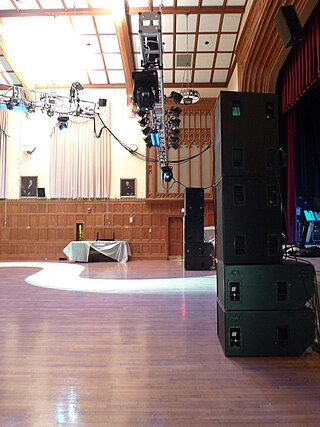
A professional audio store is a retail business that sells, and in many cases rents, sound reinforcement system equipment and PA system components used in music concerts, live shows, dance parties and speaking events. This equipment typically includes microphones, power amplifiers, electronic effects units, speaker enclosures, monitor speakers, subwoofers and audio consoles (mixers). Some professional audio stores also sell sound recording equipment, DJ equipment, lighting equipment used in nightclubs and concerts and video equipment used in events, such as video projectors and screens. Some professional audio stores rent "backline" equipment used in rock and pop shows, such as stage pianos and bass amplifiers. While professional audio stores typically focus on selling new merchandise, some stores also sell used equipment, which is often the equipment that the company has previously rented out for shows and events.

















